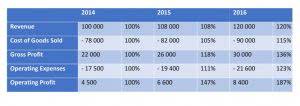Formula Example Concept

They include cash on hand, cash at banks, investment, inventory, accounts receivable, prepaid, advance, fixed assets, etc. Shareholders’ equity is the total value of the company expressed in dollars. It’s the amount that would remain if the company liquidated all its assets and paid off all its debts. The remainder is the shareholders’ equity which would be returned to them. These may include loans, accounts payable, mortgages, deferred revenues, bond issues, warranties, an equation showing the relationship among assets, liabilities, and owners equity. and accrued expenses.

Impact of transactions on accounting equation
- Both liabilities and shareholders’ equity detail how the assets of a company are financed.
- The accounting equation is a concise expression of the complex, expanded, and multi-item display of a balance sheet.
- Shareholders’ equity is the total value of the company expressed in dollars.
- It is usually considered the most fundamental concept in the accounting system.
- The total dollar amounts of two sides of accounting equation are always equal because they represent two different views of the same thing.
- Assets represent the valuable resources controlled by a company and liabilities represent its obligations.
They include accounts payable, tax payable, accrued expense, note payable, pension fund payable, etc. Accounting equation is the foundation of the double-entry in the accounting system which accounting transactions must follow. It is usually considered the most fundamental concept in the accounting system.
- The left-side value of the equation will always match the right-side value.
- This is important as some companies may not be able to survive in the long term if their assets are mainly from liabilities while their equity is too small in comparison.
- Every business transaction will be represented in at least two of its accounts if a company is keeping accurate accounts.
- The basic formula of accounting equation formula is assets equal to liabilities plus owner’s equity.
- It can be defined as the total number of dollars that a company would have left if it liquidated all its assets and paid off all of its liabilities.
- If there is, it would only mean one thing which is there is an error in accounting.
What Is the Accounting Equation?

All assets owned by a business are acquired with the funds supplied either by creditors or by owner(s). In other words, we can say that the value of assets in a business is always equal to the sum of the value of liabilities trial balance and owner’s equity. The total dollar amounts of two sides of accounting equation are always equal because they represent two different views of the same thing.
Total assets always equal total liabilities plus owner’s equity
Additionally, the equation formula may also be broken down further on the capital part to detail the additional contributions of the capital. In this case, the capital will become the beginning capital and additional contributions. The major and often largest value assets of most companies are their machinery, buildings, and property. In this case, there is no transaction that can make the equation not balanced. If there is, it would only mean one thing which is there is an error in accounting.

Expanded Accounting Equation
The total amount of all assets will always equal the sum of liabilities and shareholders’ equity. All in all, no matter the case, total assets will always equal total liabilities plus owner’s equity. Every business transaction will be represented in at least two of https://winter26.com/bookkeeper-hourly-pay-in-seattle-washington-in/ its accounts if a company is keeping accurate accounts. The borrowed money will be reflected in its balance sheet as both an increase in the company’s assets and an increase in its loan liability if a business takes a loan from a bank. These elements are basically capital and retained earnings; however, the expanded accounting equation is usually broken down further by replacing the retained earnings part with its elements. Valid financial transactions always result in a balanced accounting equation which is the fundamental characteristic of double entry accounting (i.e., every debit has a corresponding credit).

